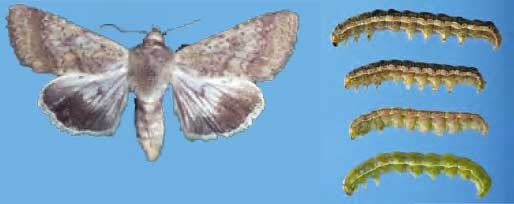Helicoverpa species (commonly known as budworms) can cause substantial crop damage and are becoming more common across all Australian growing regions.
The moth larvae can cause extensive feeding damage and also create entry points for secondary pests and diseases.
Pest identification
Heliothis larvae are cream coloured with dark-brown heads. As they mature, the larvae will become darker and develop stripes running along their bodies. These will then develop into the identifying characteristic between species of Heliothis.
Female moths generally have brown forewings, whilst males are most commonly cream coloured.
Damage
Heliothis larvae will bore into developing fruitlets causing them to either fall or become deformed.
Fruit damage usually appears as clean isolated holes in the fruit surface 5–10 mm deep and around 5 mm wide. These develop a russet lump or depression as the fruit matures. Larvae can also feed on the leaves and buds.
Monitoring
During spring and early summer, the undersides of damaged leaves should be carefully monitored for young caterpillars.
Heliothis damage can also occur in early autumn and around harvest, so trees should also be monitored then.
Management
Cultural and physical
Heliothis will lay eggs on a wide range of plants, including weeds, therefore managing these, particularly during dormancy, can help to reduce any resident population.
Biological
Protecting beneficials by using a ‘softer’, more selective insecticide program will assist with the biological control of budworm caterpillars.
Chemical
Budworms and other early season caterpillars can damage fruit before spray programs for other key moth pests have commenced.
Early spring monitoring can help to determine if early season chemical intervention is needed.
Download the Orchard plant protection guide 2020-21
See this article in Tree Fruit Dec 2020




















